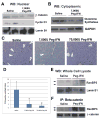Pegylated interferon alpha targets Wnt signaling by inducing nuclear export of β-catenin
- PMID: 21093092
- PMCID: PMC3052972
- DOI: 10.1016/j.jhep.2010.07.020
Pegylated interferon alpha targets Wnt signaling by inducing nuclear export of β-catenin
Abstract
Background & aims: Pegylated-Interferon-α2a (peg-IFN), a first line therapy for Hepatitis C virus (HCV) patients, also impacts the recurrence of hepatocellular carcinoma (HCC). The activation of the Wnt pathway due to β-catenin gene mutations contributes to the development of a significant subset of HCC. Herein, we explored the effect of peg-IFN on Wnt/β-catenin signaling in vitro and in vivo.
Methods: Multiple human hepatoma cell lines were treated with Peg-IFN to assess its effect on the Wnt pathway and the mechanisms involved. Transgenic (TG) mice expressing stable β-catenin mutant in the liver were exposed to diethylnitrosamine (DEN) and treated with peg-IFN.
Results: In vitro, peg-IFN decreased the transcriptional activity of β-catenin/Tcf and did so independently of JAK/Stat signaling. Peg-IFN treatment led to increased mRNA and protein expression of RanBP3, a known β-catenin nuclear export factor, in all hepatoma cells. Co-precipitation studies showed an increased association between RanBP3 and β-catenin after peg-IFN treatment. The siRNA-mediated RanBP3 knockdown abrogated Peg-IFN-induced decrease in TOPFlash reporter activity. In vivo, Peg-IFN treatment led to increased nuclear RanBP3, decreased nuclear β-catenin and cyclin D1, and decreased cytoplasmic glutamine synthetase. Increased association of RanBP3 and β-catenin was also observed in vivo in response to Peg-IFN that led to decreased hepatocyte proliferation.
Conclusions: Peg-IFN inhibits β-catenin signaling through the up-regulation of RanBP3, which may be a contributory mechanism for the delayed HCC and improved survival in treated HCV patients. This observation might have chemo-preventive or chemo-therapeutic implications in tumor with aberrant Wnt pathway activation.
Copyright © 2010 European Association for the Study of the Liver. Published by Elsevier B.V. All rights reserved.
Figures




Similar articles
-
Pegylated interferon-α inhibits the proliferation of hepatocellular carcinoma cells by downregulating miR-155.Ann Hepatol. 2019 May-Jun;18(3):494-500. doi: 10.1016/j.aohep.2018.11.007. Epub 2019 Apr 18. Ann Hepatol. 2019. PMID: 31036495
-
RanBP3 enhances nuclear export of active (beta)-catenin independently of CRM1.J Cell Biol. 2005 Dec 5;171(5):785-97. doi: 10.1083/jcb.200502141. Epub 2005 Nov 28. J Cell Biol. 2005. PMID: 16314428 Free PMC article.
-
Interferon-α2b and transforming growth factor-β1 treatments on HCC cell lines: Are Wnt/β-catenin pathway and Smads signaling connected in hepatocellular carcinoma?Biochem Pharmacol. 2011 Dec 1;82(11):1682-91. doi: 10.1016/j.bcp.2011.08.001. Epub 2011 Aug 6. Biochem Pharmacol. 2011. PMID: 21843516
-
Points of therapeutic intervention along the Wnt signaling pathway in hepatocellular carcinoma.Anticancer Agents Med Chem. 2011 Jul;11(6):549-59. doi: 10.2174/187152011796011019. Anticancer Agents Med Chem. 2011. PMID: 21554202 Review.
-
Wnt signaling in liver cancer.Curr Drug Targets. 2008 Nov;9(11):1013-24. doi: 10.2174/138945008786786127. Curr Drug Targets. 2008. PMID: 18991612 Free PMC article. Review.
Cited by
-
Comparison of the regulation of β-catenin signaling by type I, type II and type III interferons in hepatocellular carcinoma cells.PLoS One. 2012;7(10):e47040. doi: 10.1371/journal.pone.0047040. Epub 2012 Oct 4. PLoS One. 2012. PMID: 23056571 Free PMC article.
-
Secretome of brain microvascular endothelial cells promotes endothelial barrier tightness and protects against hypoxia-induced vascular leakage.Mol Med. 2024 Aug 26;30(1):132. doi: 10.1186/s10020-024-00897-6. Mol Med. 2024. PMID: 39187765 Free PMC article.
-
Insights into the infiltrative behavior of adamantinomatous craniopharyngioma in a new xenotransplant mouse model.Brain Pathol. 2015 Jan;25(1):1-10. doi: 10.1111/bpa.12148. Epub 2014 May 19. Brain Pathol. 2015. PMID: 24716541 Free PMC article.
-
Wnt6 influences the viability of mouse embryonic palatal mesenchymal cells via the β-catenin pathway.Exp Ther Med. 2017 Dec;14(6):5339-5344. doi: 10.3892/etm.2017.5240. Epub 2017 Oct 2. Exp Ther Med. 2017. PMID: 29285061 Free PMC article.
-
Complete response of Ctnnb1-mutated tumours to β-catenin suppression by locked nucleic acid antisense in a mouse hepatocarcinogenesis model.J Hepatol. 2015 Feb;62(2):380-7. doi: 10.1016/j.jhep.2014.10.021. Epub 2014 Oct 18. J Hepatol. 2015. PMID: 25457204 Free PMC article.
References
-
- Barker N, Clevers H. Mining the Wnt pathway for cancer therapeutics. Nat Rev Drug Discov. 2006 Dec;5(12):997–1014. - PubMed
-
- Cadoret A, Ovejero C, Terris B, Souil E, Levy L, Lamers WH, et al. New targets of beta-catenin signaling in the liver are involved in the glutamine metabolism. Oncogene. 2002 Nov 28;21(54):8293–8301. - PubMed
-
- Colnot S, Decaens T, Niwa-Kawakita M, Godard C, Hamard G, Kahn A, et al. Liver-targeted disruption of Apc in mice activates beta-catenin signaling and leads to hepatocellular carcinomas. Proceedings of the National Academy of Sciences of the United States of America. 2004 Dec 7;101(49):17216–17221. - PMC - PubMed
Publication types
MeSH terms
Substances
Grants and funding
LinkOut - more resources
Full Text Sources
Other Literature Sources
Research Materials
Miscellaneous

